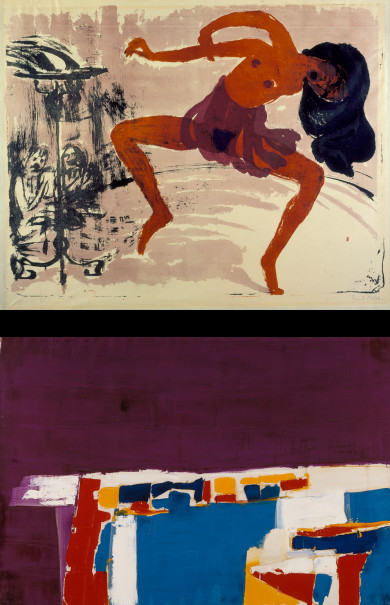Visions of the South
02 Mar - 13 Jul 2014

Top: Emil Nolde, Dancer, 1913, lithograph printed in black, brownish red, carmine, and gray-violet on simili-japan paper, image: 20 7/8 x 27 1/8 in. (53 x 68.9 cm), Los Angeles County Museum of Art, The Robert Gore Rifkind Center for German Expressionist Studies © Nolde Stiftung Seebüll, Germany.
Bottom: Nicolas de Staël, View of Marseille (detail), c. 1955, Estate of Hans G. M. De Schulthess © Nicolas de Staël Estate © 2014 Artists Rights Society (ARS), New York / ADAGP, Paris.
Bottom: Nicolas de Staël, View of Marseille (detail), c. 1955, Estate of Hans G. M. De Schulthess © Nicolas de Staël Estate © 2014 Artists Rights Society (ARS), New York / ADAGP, Paris.
VISIONS OF THE SOUTH
2 March – 13 July 2014
Through a selection of paintings, prints and photographs from the museum's rich collections, this exhibition explores the artistic vision of the South and its evolution over centuries. Throughout the history of European art, the South has served as a concept, suggesting both a geographical reality as well as fantasies of the exotic. As early as the 16th century, artists traveled to Italy in search of Arcadia, a mythical utopia, attracted by the archaeological remains of the Roman Empire set in picturesque landscapes and bathed in the warm southern light. By the 19th century, open-air painting had gained popularity, inspired by the radiant sun and the abundance of Mediterranean nature. Later, photographers journeyed throughout the Italian peninsula, depicting famous monuments and sites. By the end of the 19th century, scientific expeditions documented more distant lands, notably the islands of the South Pacific. German Expressionists, among them Emil Nolde and Max Pechstein, were even inspired to travel to the South Seas. In the 20th century, artists including Pablo Picasso, Nicolas de Staël, and Richard Seewald favored Southern France and spent significant parts of their careers there. The exhibition includes around 40 works, some of them rarely exhibited, drawn from the European Painting, Modern Art, Prints and Drawings, and Photography departments, as well as from the Robert Gore Rifkind Center for German Expressionist Studies at LACMA.
2 March – 13 July 2014
Through a selection of paintings, prints and photographs from the museum's rich collections, this exhibition explores the artistic vision of the South and its evolution over centuries. Throughout the history of European art, the South has served as a concept, suggesting both a geographical reality as well as fantasies of the exotic. As early as the 16th century, artists traveled to Italy in search of Arcadia, a mythical utopia, attracted by the archaeological remains of the Roman Empire set in picturesque landscapes and bathed in the warm southern light. By the 19th century, open-air painting had gained popularity, inspired by the radiant sun and the abundance of Mediterranean nature. Later, photographers journeyed throughout the Italian peninsula, depicting famous monuments and sites. By the end of the 19th century, scientific expeditions documented more distant lands, notably the islands of the South Pacific. German Expressionists, among them Emil Nolde and Max Pechstein, were even inspired to travel to the South Seas. In the 20th century, artists including Pablo Picasso, Nicolas de Staël, and Richard Seewald favored Southern France and spent significant parts of their careers there. The exhibition includes around 40 works, some of them rarely exhibited, drawn from the European Painting, Modern Art, Prints and Drawings, and Photography departments, as well as from the Robert Gore Rifkind Center for German Expressionist Studies at LACMA.
